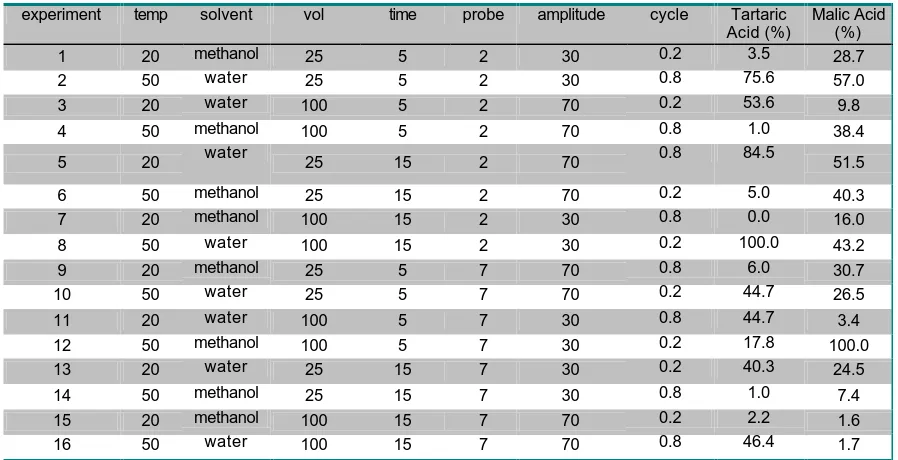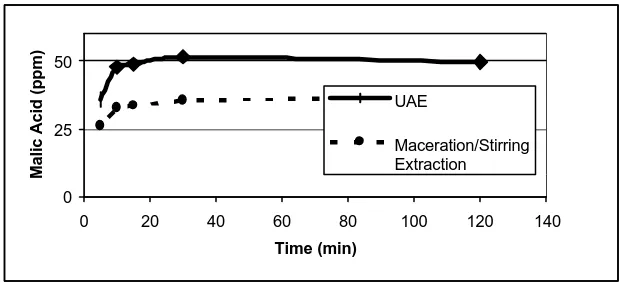ULTRASOUND-ASSISTED EXTRACTION OF COMPOUNDS FROM FOODS
PACS Reference: 43.35.Vz
Palma, M.; Piñeiro, Z.; Rostagno, M. A.; Barroso, C.G.
Departamento de Química Analítica. Facultad de Ciencias. Universidad de Cádiz.
Apdo. 40
Puerto Real, 11510
Spain.
Tel. +34 956 016360
Fax +34 956 016460
e-mail: miguel.palma@uca.es
ABSTRACT
The optimization process of an ultrasound assisted extraction method for compounds in
of the effects of several extraction variables. Relationships between all variables were examined. By
applying graphical analysis, the best extractions conditions were obtained. The most important
variables were the extracting liquid and the extraction temperature. Later, a central composite
design was applied for optimizing temperature and the composition of the extracting liquid.
The optimized method was applied to grapes and to winemaking by-products, as well as to
soy beans.
Introduction
Ultrasound-assisted extraction (UAE) can be used for extraction methods with liquid solvents
applied to analytes in solid matrices. This extraction process is fast in comparison with the
traditional methods, because of the contact surface area between solid and liquid phase is much
greater, due to particle disruption taking place.[1]
The application of UAE to plants has produced very interesting results [2], to the extent that
industrial processing has been proposed for obtaining compounds with pharmacological
properties.[3]
In this paper the UAE of different compounds presents in two solid food samples is shown. Tartaric
and malic acids in grapes as well as isoflavones in soy beans were analyzed by HPLC after the
extraction.
Experimental
Samples
Red grapes of the Napoleon variety and grape seeds from grapes of the white Palomino Fino
variety, obtained from winemaking byproducts, were used.
Around 1 g of solid grapes or 0.5 g of soy beans were used in the extractions. All samples were
freeze-dried before the extraction in order to increase sensitivity of the analysis and because of
different grape seeds could have different moisture.
Extraction
A high intensity probe ultrasound generation system of 200 W, 24 kHz was used. The instrument
was a model UP 200S from dr.Hielscher GmbH (Teltow, Germany). Its amplitude controller allows
the ultrasonic vibrations at the probe microtip to be set at any desired level in the 10-100% range of
the nominal power. Also the cycle controller allows the duration of the application of the ultrasound
to be set, to a fraction of a second in the 0.1-1.0 range.
Results and discussion
Extraction variables
The experimental design was applied only to grape seeds and the fine tuning of the extraction
method was developed for both grape seeds and whole grapes separately.
A fractional factorial experimental design was carried out in order to determine the more significant
variables for the extraction process. The experimental conditions and the concentrations of tartaric
acid and malic acid found in the extracts are shown in Table 1. It also shows the concentrations of
tartaric and malic acid found in the extracts obtained. All the concentrations are shown relative to
the amount found using the most effective conditions (100%).
Analyzing the main effect plots, it can be concluded that the more significant variables for the
extraction process are temperature and the solvent used as extracting liquid. It can be seen that the
higher the temperature, the higher the recovery. This effect is much higher for malic acid than for
Table 1. Extraction conditions in the fractional factorial experimental design.
From the graphical analysis, it can be concluded that the best conditions for extracting the two acids
are: 100 mL of extracting liquid, rather than 25 mL; a thin probe (2 mm) rather than a thick probe (7
mm); 30% of amplitude and 0.2 seconds of cycle time, rather than 70% and 0.8 seconds,
respectively.
Optimization of extraction time
The extraction time must be adjusted to obtain quantitative recoveries of both acids. To determine
the time needed, different extractions were done using increasing extraction times to establish the
kinetic of the extraction.
Both grape seed and whole grapes were used to determine separately the best extraction time. The
kinetic obtained was compared with the kinetic of the extraction method of maceration and
continuous magnetic stirring (at 1000 rpm), to determine the influence of ultrasound on the
recoveries. The resulting graph for malic acid is shown in Figure 1.
experiment temp solvent vol time probe amplitude cycle Tartaric Acid (%)
Malic Acid (%)
1 20 methanol 25 5 2 30 0.2 3.5 28.7
2 50 water 25 5 2 30 0.8 75.6 57.0
3 20 water 100 5 2 70 0.2 53.6 9.8
4 50 methanol 100 5 2 70 0.8 1.0 38.4
5 20 water 25 15 2 70 0.8 84.5 51.5
6 50 methanol 25 15 2 70 0.2 5.0 40.3
7 20 methanol 100 15 2 30 0.8 0.0 16.0
8 50 water 100 15 2 30 0.2 100.0 43.2
9 20 methanol 25 5 7 70 0.8 6.0 30.7
10 50 water 25 5 7 70 0.2 44.7 26.5
11 20 water 100 5 7 30 0.8 44.7 3.4
12 50 methanol 100 5 7 30 0.2 17.8 100.0
13 20 water 25 15 7 30 0.2 40.3 24.5
14 50 methanol 25 15 7 30 0.8 1.0 7.4
15 20 methanol 100 15 7 70 0.2 2.2 1.6
16 50 water 100 15 7 70 0.8 46.4 1.7
0 25 50
0 20 40 60 80 100 120 140
Time (min)
Malic Acid (ppm)
UAE
[image:5.612.150.461.95.236.2]Maceration/Stirring Extraction
Figure 1. Kinetics of extraction obtained for malic acid from grape seeds.
Application of UAE to soy isoflavones
Several extracting solvents were used for extracting isoflavones from soy beans. They were
selected based on the usual solvents for the analyses of isoflavones with classical extraction
methods, i.e., pure ethanol, 50% ethanol in water, pure methanol and 50% methanol in water.
The same conditions were applied for all the extractions. The relative recoveries obtained for the
extractions are shown in figures 2 for daidzin.
0,00 20,00 40,00 60,00 80,00 100,00 120,00
EtOH EtOH 50% MeOH MeOH 50% E x t r a c t i o n S o l v e n t
Daidzin
UAE Stirring/mixing
Figure 2. The relative recoveries obtained for the extractions of daidzin
The results obtained by UAE were compared to the corresponding recoveries obtained applying a
methanol for a couple of compounds, the UAE produced at least a 10% higher recovery that the
soaking/stirring extraction method. The differences are more significant for the solvent which
produced the best recoveries, i.e. 50% methanol in water. It was obtained between 30% and 200%
higher recoveries using UAE.
Conclusions
Under the optimized extraction conditions, quantitative recovery is obtained for tartaric and malic
acids after 30 minutes of extraction and the method has high repeatability.
For grape seeds, UAE offers considerable advantages over the conventional maceration/stirring
extraction method, but for grapes the differences are less marked.
For isoflavones, significant higher recoveries were obtained by UAE vs the soaking/stirring
extraction for all the extracting solvents assayed.
Acknowledgements
Support of the Spanish Inter-Ministerial Commission for Science and Technology under the
framework of the project 1FD1997-0683 is gratefully acknowledged.
Literature Cited
[1] A. V. Filgueiras, J. L. Capelo, I. Lavilla, C. Bendicho, Talanta 53 (2000) 433.
[2] Z. Hromádková, A. Ebringerová, P. Valachovic, Ultrason. Sonochem. 5 (1999) 163.

